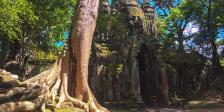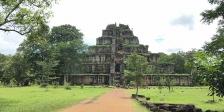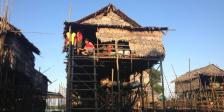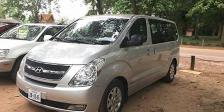Cambodia was A KHmer Emprier Cambodia today only cover a land area of 181,035 square kilometers in the southwestern part of the Indochina peninsula, about 60 percent of which is used for agriculture. Private campanies for Land investment of course for It lies completely within the tropics with its southern most points slightly more than 10° above the Equator. The country capital city is Phnom Penh.
Cambodia Shares borders are shared with Thailand and the Lao People’s Democratic Republic on the West and the North, and the Social Republic of Viet Nam on the East and the Southeast. The country is bounded on the Southeast by the Gulf of Thailand. In comparison with neighbors, Cambodia is a geographical contact country administratively composed of 24 provinces now day, three of which have relatively short maritime boundaries, 2 municipalities, 172 districts, and 1,547 communes. The country has a coastline of 435 km and extensive mangrove stands, some of which are relatively undisturbed..
The dominant features of the Cambodian landscape are the large, almost generally located, Tonle Sap (Great Lake) and the Bassac River Systems and the Mekong River, which crosses the country from North to South. Surrounding the Central Plains which covered three quarters of the country’s area are the more densely forested and sparsely populated highlands, comprising: the Elephant Mountains and Cardamom Mountain of the southwest and western regions; the Dangrek Mountains of the North adjoining of the Korat Plateau of Thailand; and Rattanakiri Plateau and Chhlong highlands on the east merging with the Central Highlands of Viet Nam.
The Tonle Sap Basin-Mekong Lowlands region consists mainly of plains with elevations generally of less than 100 meters.
As the elevation increases, the terrain becomes more rolling and dissected.
The Cardamom Mountains in the southwest rise to more than 1,500 meters and is oriented generally in a northwest-southeast direction. The highest mountain in Cambodia –Phnom Aural, at 1.771meters – is in the eastern part of this range.
CAMBODIA AIRPORT TAXI & VISAS
Cambodia International Airport
Phnom Penh and Siem Reap Airport Tax:
- Foreigner: USD25
- Cambodian: USD18
Domestic:
- Foreigner: 6USD
- Cambodian: 5USD
Passport/visa requirements: In order to visit Cambodia, a visa is required for most nationalities. A passport with at least six month validity is required. Philippine and Malaysian nationals do not require tourist visas for a stay up to 21 and 30 days respectively. Singaporean nationality is also exempt from the usual visa requirement.Visa on arrival is not permitted for holders of the following passports: Afghanistan; Algeria; Bangladesh; Iran; Iraq; Pakistan; Saudi Arabia; Sri Lanka; and Sudan. Holders of these passports must obtain a Cambodian visa before arriving in the country. Holders of these passports are also required to hold a sponsor letter or invitation from a company / organization / travel agent, and you are also advised to hold a valid return ticket.
Availability: It is very easy to travel to Cambodia. Cambodian visas are available to most nationalities on arrival at all international airports in Cambodia (Phnom Penh and SiemReap), at overseas Cambodian embassies , at most international border crossing checkpoints in Cambodia, and through the online E-Visa procedure.Issuance requirements and price: Issuance of a visa on arrival at the airports and international border crossings is relatively quick and easy, taking about 20-30 minutes. One 4x6 photo is required.
30-day tourist visa (Type ‘T’): US$20Tourist visas can be extended for one month, but only one time. 30-day business visa (Type ‘E’): US$25 Business visas can be renewed indefinitely, one month, three months, six months or one year at a time.
Diplomatic, Official, Courtesy, and Special (Cambodian) visas are issued free of charge.
At overland international border checkpoints with Thailand, visa prices are often set in Thai baht making them significantly more expensive than the official visa price in US dollars. See below.
E-Visa: The Cambodian Ministry of Foreign Affairs now offers 'e-visa' - visas available online through the Ministry's website. Scan of passport and passport size photo required. Payment by credit card. US$25 for a 30 day visa (three month validity.) Processing time: 3 days. Issued by email and print from from your computer. The Ministry recently announced that e-visa entry points now include Siem Reap International Airport, Phnom Penh International Airport, the Bavet/Moc Bai border crossing, the Poipet/Aranyaprathet border crossing and the Koh Kong/Had Lek border crossing. To order an E-visa see the followingwebsite: http://www.mfaic.gov.kh/e-visa/vindex.aspx
E-Visa NEWS/WARNING - In March13, 2009 the Ministry of Foreign Affairs issued a warning about certain websites selling fraudulent e-Visas. Do not purchase e-Visas throughany website other that the official Cambodian Ministry of Foreign Affairs Website.
E-Visa NEWS - Getting an e-visa is easy, requiring only 5 minutes or so, when the website is working. Unfortunately the website seems to go down with some regularity, often for days at a time. If you really need an e-visa and the site is down, just keep trying. It does seem to come back on line after a while.
Visa Renewal: Renew visas through a travel agent or the ‘Immigration Department’ on Confederation de Russie (‘Airport Road’), located opposite Phnom Penh International Airport. Tel: 012-581558. Fax: 023-890380. E-mail: visa_info@online.com.kh. Renew Diplomatic, Courtesy and Official visas at the Consular section of the Ministry of Foreign Affairs.
Visas at Overland Border Crossings
Border crossing with Laos: Border policies are not stable. Travelers report that Cambodian visas are available at the border but Laotian visas are not available at the border.
Border crossings with Vietnam: Cambodian visas are available at the Moc Bai/Bavet and 'Chau Doc' border crossings. There is conflicting information about the availability of Cambodian visas at Prek Chak. Vietnamese visas are not available at any overland border crossing.
Border crossings with Thailand: Cambodian visas and 30-day Thai transit visas are available at all Thai/Cambodian border crossings. Thai transit visas are free of charge. Other types of Thai visas are not available.
Border Crossing Scams/Annoyances
Be prepared for minor scams at the overland border crossings, especially at Koh Kong and Poipet, though similar reports are beg. Scam #1: The most consistently reported inconvenience at the border is being overcharged for Cambodian visas. At the Poipet and Koh Kong crossings, Cambodian immigration usually charges 1200-1500 baht for a tourist visa and 1500-1700 baht for a business visa. Unlike the rest of the country, they usually refuse dollars. At current exchange rates, the price in baht is significantly more expensive than the official prices of $20 and $25. Some people have had some success paying the official price in dollars by being politely insistent. Another way to try to avoid the problem is to get an e-visa in advance so that you don't need to get a visa at the border.
Scam #2: Drivers and touts will insist that you need their help to obtain a visa. This is not true. They want to charge an extra fee. The visa process is easy, straightforward and do-it-yourself. Do not accept their ‘assistance’ as it is not necessary and will only lengthen the process and increase the cost.
Scam #3: Immigration police may try to charge 100 baht for the normally free exit/entry stamp. Try asking for a receipt.
Scam #4: Immigration police may try to charge 100-300 baht for a SARS Form and/or Swine Flu Form. These forms, when they are required, are supposed to be free. Try asking for a receipt.
When dealing with officials, there is usually room for polite explanations and bargaining. One sometimes-successful approach is to smile, say "no, thank you", smile some more, perhaps act like you don't understand and walk away. This technique may or may not work but it has a greater likelihood of success than simply refusing to do what they are asking or, even worse, becoming argumentative or showing anger.
CAMBODIA MONEY AND BANK
US$1.00 = ~4000 Riel
Cambodian riel (R) is the official tender in Cambodia but the US dollar is the de facto currency and the most useful for the average visitor to Cambodia. Most hotels and restaurants, shops, taxis, buses and airlines set their prices in US dollars. Even the visa prices and departure taxes are set in US dollars. Small transactions (less than a dollar) are usually done in Cambodian riel. Change of less than $1 is given in riel. Always carry some small riel for motorcycle taxis (motodups), snacks and other small purchases.
There is no coinage in Cambodia, only currency notes. Cambodian riel notes come in 50, 100, 500, 1000, 2000, 5000, 10,000, 50,000 and 100,000 denominations, but the distinctive red 500 riel note and the 1000 riel note are the most useful and common.
Banks There are banks in all provincial capitals in the country, including Phnom Penh, Siem Reap, Sihanoukville, Kampot and Battambang. Banks offer the usual banking services - cash advances on credits cards (most accept Visacard,) international currency exchange, telegraphic transfers, cash travelers checks and ANZ Royal Banks, Canadia and SBC Banks offer ATMs with international access. Most banks are open from 8:00 to 15:00 or 16:00PM, Monday through Friday. Some are open Saturday mornings until 11:30. ATMs are available 24 hours.
For bank listings and contact details see the individual city listings:
Siem Reap Banks
Phnom Penh Banks
Sihanoukville Banks
Money Changers Money changers offer a slightly better rate that the banks. They are plentiful and tend to cluster around the traditional markets and there is usually a section within the market dedicated to moneychangers and gold sellers.
When accepting US dollars in change, inspect the bills carefully. Marred riel is acceptable tender, but the tiniest tear in a large US note, especially a $20, $50 or $100 note, renders it all but useless in Cambodia. Banks, moneychangers and other businesses will not accept it.
Credit Cards In the major tourist towns, credit cards are accepted at most upscale hotels, shops and restaurants, some mid-range place and a growing number of other businesses. Credit cards are general not accepted at any businesses outside of Phnom Penh, Siem Reap, Sihanoukville and the casinos in Poipet. Visa, MasterCard (MC) and JCB cards are the most widely accepted credit cards in Cambodia. AMEX is coming into wider use, as well as the newANZ Bluespot card. Diners Club (DC) is accepted at very few place. Most businesses charge a 2%-4% fee to accept credit cards.
ATMs There are now ATMs with international access in Phnom Penh, Siem Reap, Sihanoukville, Kampot and Battambang. ANZ Royal Bank and Canadia Bank ATMs both accept Cirrus, Plus, Maestro, Visa and MasterCard systems.SBC Bank ATMs accept Visa and MasterCard. All ATMs dispenses US dollars. There For locations see the ATM icons on the city maps.
Travelers Checks Travelers checks are accepted at most banks, major hotels and restaurants and some money changers. AMEX in US dollars are the most widely accepted travelers checks.
Cash Transfers 'Instant' cash transfers can be done through MoneyGram or Western Union. Ordinary telegraphic transfers are available at all major banks.
WEATHER AND CLIMATE
Cambodia is located in Southeast Asia, in the tropical zone, just 10-13 degrees north of the equator. Like most of Southeast Asia, Cambodia is warm to hot year round and the climate is dominated by the annual monsoon cycle with its alternating wet and dry seasons. The monsoon cycle is driven by cyclic air pressure changes over central Asia. As the pressure drops during the summer months (June through October), moist air is drawn landward from the ocean bringing the southwest monsoon rains to Cambodia and much of Southeast Asia. Come the winter months (November through May), the air pressure over central Asia rises, driving cool dry air back across Southeast Asia and bringing on a largely rainless dry season to Cambodia. The mean daily temperature also rises and falls with the winter and summer months, but not exactly in time with the wet and dry season, effectively creating four annual seasons in Cambodia:
1) November-February: Cool and dry. Average mid-day temperatures in the mid 20s, sometime dipping below 20 at night. The monsoon rains trail off through October and November, and have usually stopped completely by mid November. These months - November through February - are generally considered to be the best time of year to visit, with December and January offering the very best weather of the year across the country - comfortably warm days, clear skies, no rain, light breeze, cool evenings. Ideal beach weather in Sihanoukville. A comfortable time of year to visit the temples near Siem Reap. Temperatures begin to creep up a bit through February and there are occasional, short 'mango showers' in the afternoon.
2) March-May: Hot and dry. The dry season continues, the only precipitation being short 'mango showers' in the afternoons that slowly increase in frequency and intensity through these months. During these months river and lake levels are very low, generally making boat/river ferry travel much more difficult, less reliable and can greatly increase travels times dramatically. On the other hand, road travel (bus, taxi, motorcycle) is much easier and more reliable for lack of rainy season flooding. The temperature slowly rises through February and March, peaking out in April and May before the monsoons begin. February and March are still comfortable but by April mid-day temperatures can hover in the mid to upper 30s, especially in inland areas like Siem Reap. It is less breezy at this time of year, the sun can be quite intense and the air becomes hazier with the rising humidity. Though sometimes quite hot, the lack of rain still leaves this a good time of year to visit the temples or the beach.
3) June-August: Hot and wet. The hot season continues but is fairly quickly moderated as the monsoon rains begin in May and June, cooling, if only a bit, the hot, humid air. Across most of the country, the monsoon rains are fairly predictable, usually occurring in the afternoon or at night. And the afternoon rains usually last no more than a couple of hours making them fairly easy to plan around, especially if you are visiting the temples or touring. In fact, the Angkor temples are at their aesthetic best during the wet season. The surrounding moats and reflecting pools are full, the jungle is lush and moisture bring outs the colors of the moss and lichen covered stones of the temples. Boat travel becomes easier and more reliable as the season progresses and the river and lake levels rise, but some roads sometimes deteriorate or become temporarily flooded. The pattern of monsoon rains tends too be different along the coast and the beach towns, where the rains are more frequent and, when the season is at its peak, may last for days at a time, though, unlike the rest of the country, the rain on the coast may stop for days at a time as well.
4) September-Early November: Cool and wet. The air doesn't really begin to cool much until October or November, but still, its cooler than the hottest months. In September the temperatures hover in the mid 30s and slowly drop through the following months. By October, the mid day temperatures are around 30. In September the rainy season is just passing its peak. The rains are still very regular and intense in September, but by October the frequency is usually dropping off considerably. By the end of October the rains are close to stopping completely, if they haven't already. As the rains end through October, the best time of year to visit Cambodia begins.
The Rainy Season
Many travelers understandably try to avoid visiting Southeast Asia during the wet season, assuming that the rains will spoil the visit. There are obvious disadvantages to visiting during the rainy season, but personally it is my favorite time of year in Cambodia. During the rainy season the temples of Angkor are at their most beautiful and most photogenic. The reflecting pools and moats are full, the vegetation is deep green and the wet stone of the temples is at its most colorful. Also of photographic note, the rain-washed air of the wet season is particularly clear as compared to the hazy, smoky skies of the dry season, making those long shots of the temples and rice paddies that much clearer. (If you always wanted that shot of from the top of Phnom Bakheng of the distant Angkor Wat in the jungle illuminated the light of sunset, this is the best time of year to bring your 400mm lens and give it a try.) Outside the cities, the rice paddies are full of water and green with new rice, the jungle is lush and the countryside is picturesque and alive with growing season activity. The river and lake levels are high making boat travel easy. (It's the best time of year to take the boat from Siem Reap to Battambang, reputedly one of the most picturesque boat trips in Cambodia.) And it must be said that there are fewer tourists in the country. The temples are less crowded, prices are lower and the bars and restaurants are all happy to see you. And, practically speaking, it does not rain all of the time or even every day during the rainy season. When it does rain it usually starts around 2:00PM or 3:00PM and lasts a couple of hours, making it easy to plan around in most cases. Toward the beginning and the end of the season the rains occur with far less frequency.
RELIGION:
Theravada Buddhism is the official religion in Cambodia which is practiced by 95 percent of the population-- just like that of Thailand, Burma, Sri Lanka. However, Christianity and Cham Muslim are being active and popular among a large number of population as well in the capital and provinces, showing a sign of growth. Dadaism and Confucianism are also commonly practiced among the Chinese people.
Buddhists see the universe and all life as part of a cycle of eternal change. They follow the teaching of Buddha, an Indian prince born in the sixth century B.C. Buddhists believe that a person is continually reborn, in human or nonhuman form, depending on his or her actions in a previous life. They are released from this cycle only when thy reach nirvana, which may be attained by achieving good karma through earning merit and following the Buddhist path of correct living.
Earning merit is an important of Buddhist life. Buddhists in Cambodia earn merit by giving money, goods, and labor to the temples, or by providing one of the two daily meals Breakfast and Lunch to the monks.
Children often look after the fruits trees and vegetable gardens inside their local wat, or temple. Boys can earn merit by becoming temple servants or novice monks for a short time. Most young men remain monks for less than a year.


 Hot Line: +855 88 7272 445
Hot Line: +855 88 7272 445










.jpg)

